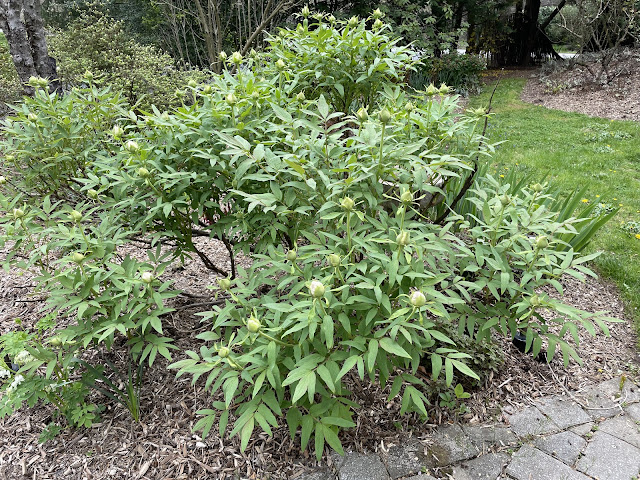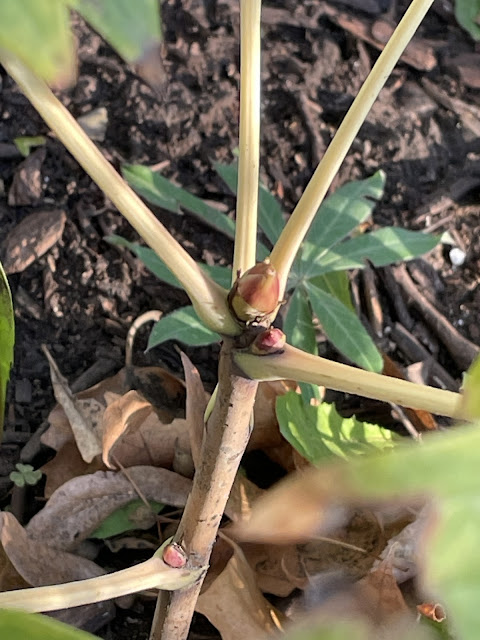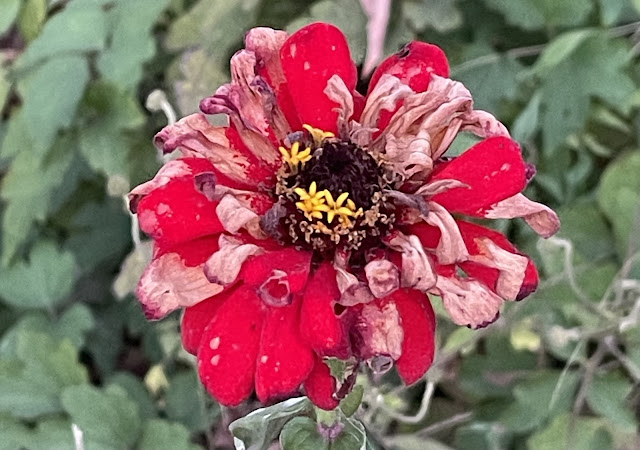We are home.
It is cold.
We live in Iowa.
Actually we only had about 2 inches of snow. It is cold but it is not below zero. The expression "it could be worse" is starting to be used a lot. At work I celebrate that I get to have most of my hearings by zoom. I think I am one of those old people drivers that used to annoy me. I turn corners going about 15 mph.
2025 is here. It seems like it was only yesterday when we were worried about Y2K. Remember that?
While this new year presents some big scary possibilities, for the moment I will try to be positive.
Let us start with the fact that the sun finally appeared. It was gloomy for the longest time.
When we drove home from work Friday night the crescent moon had a bright friend, probably the planet Venus. Coming home from work in the dark is one of the January features of living in Iowa.
The winner was the violet. It was not close.
Here is the final vote.
Scilla is also known affectionately as squill. It is the early blue carpet, all over the garden. According to a definitive source it comes from Europe, Africa, southwest Asia and the middle east. It would be easier to list where it does not come from.
It was written about by the Greeks and Romans.
It is a cousin of chionodoxa.
The common blue variety is sold under the name "s. siberica Spring Beauty."
It seeds like crazy. As spring spreads in the garden you can see the scilla seeds sprouting and making the next generation.
I grew this iris forever. Then about 2 years ago it disappeared. I found more in a catalogue, and here are some of them. I was relieved because sometimes when you go to get an old plant, it is no longer sold.
This iris blooms in the spring, about the time the short bearded iris are starting to bloom. It grows from a bulb, not a rhizome. As such it is different from the bearded type.
The foliage looks a little like a lily.
It is named after the city of Bukhara in Uzbekistan.
I love epimedium. I have about 20 varieties. My enthusiasm for these spring beauties peaked about 10 years ago. They bloom very early, and the flowers are very small. They are actually very hard to photograph.
Epimedium plants are also known as barrenwort, bishop's hat, fairy wings, horny goat weed, or yin yang huo.
Mostly they come from China.
Some are evergreen, maintaining their colorful leaves throughout the winter. These should be pruned back in very early spring.
Here is an article about care.
I read they are deer resistant. One more thing on the plus column.
#4 Fading Zinnia
November 2, 2024
I love zinnias. So do the deer. I had a few that bloomed this year. Some of the flowers were even more interesting, as they were fading.
#5 White Tree Peony
May 4, 2024
These lovelies are home grown in all respects. The plant, and three of its companion blooming plants, were grown from seed in the garden. The seed came from my sister's yard in Maryland. She has identified the plant as Phoenix White, obtained from the Cricket Hill nursery probably 20 years ago. Here is the webcite for Cricket Hill.
I carefully planted some of the seed I got from my sister about ten years ago and waited. Nothing. The seeds did not grow. So I just planted the remaining seed and forgot about it. Sure enough, the next spring I noticed little plants I thought looked like peonies. Well they were. Four years later the first one bloomed. That was in 2016. You can see the blog post from May 8, 2016 in the archives section of the blog. It is always a wonderful moment when a plant blooms for the first time. When you have grown it from seed for 4 years it is even more special.
There are now four blooming sized plants from this seed pool. One was buried by a snow pile 4 winters ago and broke off at the base. Remarkably or predictably, it grew back. It is now big enough to bloom, even though you can pick out which plant had to grow back.
Since the success with seeds I have been planting all the seed I harvest in September. Then I wait to see what happens.
I have about 2 dozen seedlings at this point, throughout the garden, ranging in age from 1-4 springs. If things take a long time to grow, it helps if you have some in various stages of development.
I even had enough seedlings to put some out for the foodbank sale.
The oldest of these seedlings bloomed in 2024. It was the grandchild of my sist4er's plant.
Pictures are in the bonus section.
The first year seedlings die back to the ground that first winter. In the next 1-2 years they develop a woody stem, that does not die back. The 3 of the biggest and oldest of these seedlings grew to about 10 inches tall this summer. But what is exciting is that they set a bud, or two. That is what mature plants do in the fall. They set the buds for the following spring. The buds then live through the very cold and blooms in the spring.
Bonus Section
Tree peonies
Let me tell you about where the white peonies came from.
All the white ones came from seeds from my sister. She lives in Maryland. I collected some seed when I visited her long ago.
Here is the parent plant in my sister's yard. We estimate it to be about 20 years old. It took off several years ago when a nearby tree came down. More sun. The plant came from Cricket Hill, the tree peony nursery in Connecticut.
https://www.treepeony.com/
If you have time there are videos on this website.
After the flower blooms it has a wonderful transition to the seed pods.
This is a few weeks after flowering.
Here is one of the mature seedpods. They are really quite beautiful, just there in the seeds pods.
Seedlings
Here is what a seedling looks like in late April, 2024. This would have been planted in September, 2023. Last spring was early and so many plants germinated. I must have had 20-25 first year seedlings last year, enough to put some on the plant sale table.
In this picture you can still see the seed.
After 2-3 years the new plants are getting ready to bloom. I had enough plants that age that I was able to dig one up in the fall and add it to the sale table. You can see the bud which developes by fall, to bloom the following spring.
Those buds are out there, in the cold all winter.
This is a video from 2019. It is when I discovered the first seedling from the earlier picture. I think I can now post videos. My computer must have updated to fix whatever problem there was in posting videos.
Here is this little plant in 2020, its second year.
Right below it is the little plant, yesterday. It should finally bloom in May. I do want to protect it from any big snow we might get. Maybe I will cover it with a big pot when the big snow comes. It is not the same yellow plastic straw.
I should add that I think 6 years from sprout to bloom is a little long. I would hope for 4 at the least.
Epimedium
This epi is a fast grower and can form a nice sized clump. It goes well with bluebells.
I was wondering when this picture was taken. Then I saw the bluebells.
More bucharica iris
Everything looks good with bluebells.
Another fading zinnia
Right Now
Lantana
In the fall of 2023, realizing that lantana would get big in a second year, I dug up and brough in several plants, before the frost killed them. I took cuttings from one and kept the other mostly intact. I then took it out in May and it grew to a nice size.
When the killing freeze was coming in 2024 I dug a few small plants as I had done the year before. I also dug up the big one.

It was ok for a few good cool and wet days. Then all the leaves fell off.
I trimmed it back, to may 18 inches, and brought the dead looking plant inside. I just left it under the cardtable where I grow my cattleyas.
A few weeks ago I looked at it. It had new growth all over it.
Here it is today.
The lesson is from the Princess Bride. Often plants are only "mostly dead."
I am really looking forward to how bug it can get this coming summer.
Julia's recipe
Tartiflette- potatoes with bacon and onion and cheese.
Tartiflette is a fancy name for a potato dish with bacon and onion and Brie. I looked it up, and tartiflette is an Arpitan word. Arpitania is another name for a western part of the Alps where in some earlier time, folks thought of themselves as their own country and spoke some variant of French. So there's the name. I saw an episode of America's Test Kitchen where they made this dish, but I couldn't access the recipe on-line so I found a version on the NYT website that was a bit more straightforward. I'm okay with straightforward.
The ingredients:
4 oz. bacon (about 4 thick slices);
3/4 cup diced onion;
1/2 teaspoon smushed garlic;
1/2 teaspoon dried thyme;
a pinch of nutmeg;
2-1/2 cups peeled and cubed potatoes (I used Yukon gold and red);
1/3 cup or so white wine;
4 oz. Brie;
1/2 cup creme fraiche; and
salt and pepper
Ingredient notes: 1) I used Brie. You could use Camembert or something called Reblochon. A soft cheese with a pale rind. 2) I used creme fraiche, as the recipe said. I think sour cream would be a perfectly fine substitute. 3) I get my bacon from a farmer. So I took out a package weighing about a pound and hacked off about 3 inches. I think 4 strips of thick bacon would be about the same amount.
I started by peeling the onion and cutting the bacon into little pieces. Then I diced the onion.
And I turned the oven on to 375 degrees.
Then I washed the potatoes and cut off any weird spots. I did not peel the potatoes. Then I cut them into bigger cubes.
I put a big skillet on the stove and added the bacon to the cold skillet. I cooked the bacon over medium heat.
When the bacon was part way done (not yet crisp, but having rendered some bacon fat), I added the onions and cooked for about 5 minutes. Then I added the smushed garlic, the thyme and a bit of nutmeg.
I cooked for about 1 more minute - until I could smell the garlic.
Then I added the potato cubes to the skillet.
I stirred the contents of the skillet around to make sure the potatoes were coated with the bacon-onion-garlic mixture.
Then I added the wine and 1/2 teaspoon each of salt and pepper.
More stirring. Then I covered the skillet and let it cook (still on medium or medium-low) for about 20 minutes. At that point, the skillet was pretty dry and the potatoes were kind of done but not completely done.
While the skillet cooked, I cut the Brie in half horizontally. And I cut each half into wedges.
So I took the skillet off the heat. I plopped the creme fraiche into the skillet.
I stirred the creme fraiche into the potato mixture.
And I scattered the little cheese pieces all over the top.
I put the skillet in the oven (uncovered) and baked it for about 25 minutes.
At the end of that time, the potatoes were completely tender. The cheese was softened.
And here it is. I served it from the skillet. It would have been fussy (and difficult) to try to move the skillet contents to a serving dish.
We served this with simply prepared salmon and green beans and salad. The tartiflette was the star in terms of flavor so the other dishes were sort of plain. And we had baked custard for dessert. A nice mid-winter meal.
Odds and Ends
We are ready for winter.
The new garden season has officially begun. On January 1, 2025 I planted my first seed.
I planted two kinds of lettuce, including one that is close to black.
The seed packet suggests that it will be ready in 55 days. So far, no sign of anything.

I know that lupines grow well for me inside, from seed. Maybe I will try them next.
I will start the poppies about February 1.
Winter is a cold reality in Iowa. But it will pass.
We have a cold reality in this country and in the world.
Its passing might take some time.
Pray for peace.
Pray that kindness will spread.
Remember Jimmy Carter. He was kind.
Do some good work, every day.
I do so much appreciate your notes. They keep me going when it is so dark out.
Philip













































4 comments:
This contest was a tough one for me. It came down to the white tree peony and the fading zinnia. I suspect the peony will win the contest, but I chose the zinnia, the Johnny Cash of zinnias. Enjoyed the video, too, with the surprise ending.
I don’t think I’ve heard of, let alone tried tartiflette.it looks delicious. It’s cold here too. I swear that 25°F is colder than it used to be.. hang in there.
I had no difficulty at all in choosing the tree peony. I liked the cheerful group of shining luminous faces, plus the surroundings--all those variations of green! And the stories about seeds and expectations are entertaining too.
I am very fond of lantana. When we lived in CT, an acquaintance of ours grew lantana in tree form as a standard. What nice potted trees he had. They spent the winters in a warm greenhouse.
I love that potato idea. And tartiflette is a beautiful name. What's not to like about potatoes, bacon and cheese?
A much overdue letter is in the works. Stay warm, calm, and positive.
"Anonymous" was me. Forgot to add my name.
I voted for the zinnia this week. My heart however was with the peony. Every picture comes with a story. Growing a plant from seed is special. Growing a plant from seed that will not bloom for years is even better. I guess that is like planting a tree. I have not done that much. We planted the dogwood years ago. We were young at the time. When you plant a tree you really are thinking about the future, the way in the distance future. The future you may not see. I think about that more these days.
Post a Comment